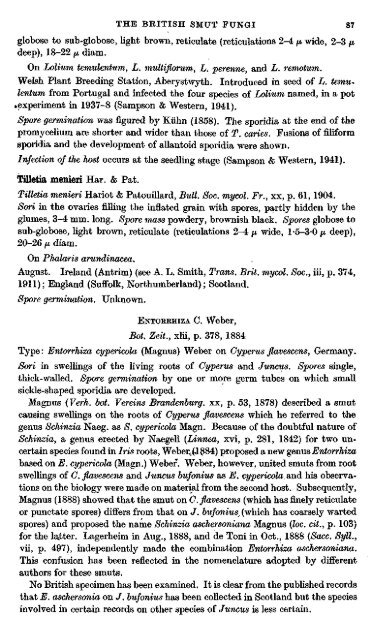nmm sP
nmm sP
nmm sP
Create successful ePaper yourself
Turn your PDF publications into a flip-book with our unique Google optimized e-Paper software.
THE BEITISH SMUT FUNGI 87<br />
globose to sub-globose, light brown, reticulate (reticulations 2-4 JJ, wide, 2-3 /A<br />
deep), 18-22 fi diam.<br />
On Lolium temulentum, L. multiflorum, L. perenne, and L. remotum.<br />
Welsh Plant Breeding Station, Aberystwyth. Introduced in seed of L. temulentum<br />
from Portugal and infected the four species of Lolium named, in a pot<br />
.experiment in 1937-8 (Sampson & Western, 1941).<br />
Spore germination was figured by Kiihn (1858). The sporidia at the end of the<br />
promycelium are shorter and wider than those of T. caries. Fusions of filiform<br />
sporidia and the development of allantoid sporidia were shown.<br />
Infection of the host occurs at the seedling stage (Sampson & Western, 1941).<br />
Tilletia menieri Har. & Pat.<br />
Tilletia menieri Hariot & Patouillard, Bull. Soc. mycol. Fr., xx, p. 61, 1904.<br />
Sori in the ovaries filling the inflated grain with spores, partly hidden by the<br />
glumes, 3-4 mm. long. Spore mass powdery, brownish black. Spores globose to<br />
sub-globose, light brown, reticulate (reticulations 2-^ fj, wide, 1-5-3-0 /A deep),<br />
20-26 fx. diam.<br />
On Phalaris arundinacea.<br />
August. Ireland (Antrim) (see A. L. Smith, Trans. Brit, mycol. Soc., iii, p. 374,<br />
1911); England (Suffolk, Northumberland); Scotland.<br />
Spore germination. Unknown.<br />
ENTOEEHIZA C. Weber,<br />
Bot. Zeit., xlii, p. 378, 1884<br />
Type: Entorrhiza cypericola (Magnus) Weber on Cyperus flavescens, Germany.<br />
Sori in swellings of the living roots of Cyperus and Juncus. Spores single,<br />
thick-waUed. Spore germination by one or more germ tubes on which small<br />
sicklei-shaped sporidia are developed.<br />
Magnus (Verh. bot. Vereins Brandenburg, xx, p. 53, 1878) described a smut<br />
causing swelhngs on the roots of Cyperus flavescens which he referred to the<br />
genus Schinzia Naeg. as S. cypericola Magn. Because of the doubtful nature of<br />
Schinzia, a genus erected by Naegeli {Linnea, xvi, p. 281, 1842) for two uncertain<br />
species found in 7ns roots, Webert|1884) proposed a new genus Entorrhiza<br />
based on E. cypericola (Magn.) Weber. Weber, however, united smuts from root<br />
swellings of C. flavescens and Junxyus bufonius as E. cypericola and his observations<br />
on the biology were made on material from the second host. Subsequently,<br />
Magnus (1888) showed that the smut on C. flavescens (which has finely reticulate<br />
or punctate spores) differs from that on J. bufonius^ (which has coarsely warted<br />
spores) and proposed the name Schinzia aschersoniana Magnus {foe. cit., p. 103)<br />
for the latter. Lagerheim in Aug., 1888, and de Toni in Oct., 1888 {Sacc. Syll.,<br />
vii, p. 497), independently made the combination Entorrhiza aschersoniana.<br />
This confusion has been reflected in the nomenclature adopted by different<br />
authors for these smuts.<br />
No British specimen has been examined. It is clear from the pubhshed records<br />
that E. aschersonia on J. bufonius has been collected in Scotland but the species<br />
involved in certain records on other species of Juncus is less certain.

















